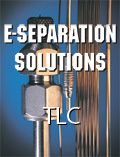Thin-Layer Chromatography
Thin-layer chromatography (TLC) provides analysts with a simple and quick method for examining the components in a mixture, and advances in the technique such as high performance TLC (HPTLC) offer higher resolution and greater reproducibility. Joining us for this discussion on TLC this month are Ned Dugan of Analtech, Inc., and Ling Bei and Dave Lentz of EMD Chemicals.

Thin-layer chromatography (TLC) provides analysts with a simple and quick method for examining the components in a mixture, and advances in the technique such as high performance TLC (HPTLC) offer higher resolution and greater reproducibility.
Joining us for a discussion on TLC this month are Ned Dugan of Analtech, Inc., and Ling Bei and Dave Lentz of EMD Chemicals.
TLC is known as a mature technique, but how has it grown in the last few years?
Dugan:It was over 100 years ago that botanist Mikhail Tsvet first separated the pigments in leaves and called the process chromatography. Mature is simply an observation of the time sequence of history, with newer techniques being developed and refined all the time.
Let’s compare this to another science — astronomy. TLC is like the telescope. It has been around for centuries and newer versions are available (radio telescopes, infrared telescopes, and so forth), but the basic design is still in existence and has an application in science.
Bei & Lentz: The TLC market has been mature for many years now but yet has tremendous untapped potential for growth. The vast majority of users are not really tuned in to how TLC technology has continued to evolve over the years, especially in the past decade. A big growth area lately has been high performance TLC (HPTLC) applications, as HPTLC allows quantifiable results and offers superior resolution and reproducibility compared to conventional TLC due to its smaller, spherical particles with tighter size distribution ranges. TLC is evolving from mostly qualitative use toward true quantitative analysis.
TLC has the advantage of many decades’ worth of published applications to tap into for just about every field of analysis there is. In many ways, it rivals those of high performance liquid chromatography (HPLC) and gas chromatography (GC) and keeps it always relevant to changing trends in the industry.
What developments have you the most excited or intrigued in TLC?
Dugan:There are two categories that come to mind. First, I’m excited to see TLC making a significant difference in people lives, whether that’s protecting people from counterfeit anti-malarial medication or helping law enforcement catch criminals through ink analysis.
The second category involves applications that a person just wouldn’t normally think about. For example, using TLC to determine the difference between diesel smokes (whether the smoke contains a potent carcinogen or not). That makes me wonder just how TLC is going to be applied in the next 5–10 years.
Bei & Lentz:Anything that will help spread the word that TLC does more than you think and that it can help solve a lot of modern problems.
Continued automation and software breakthroughs have allowed TLC users to control variables and achieve better reproducibility and faster results and to finally develop rugged, validated methods. Now it also allows them to interface with lab data and LIMS systems. The HPTLC-mass spectrometry (MS) interface is a major innovation that will open up many new areas of applications for TLC especially in proteomics. Laser-encoded serialized plates are now available for cGMP work. The rapidly growing worldwide interest in natural products and botanicals research can easily draw from the rich archive of TLC application literature going back a half century.
Some specific recent advances include video densitometry which makes TLC regulated-lab friendly. Continued improvements in plate development processes, such as the use of overpressured-layer chromatography (OPLC) and pressurized planar electrochromatography (PPEC) were presented at HPLC 2010 this year, Also, continued advances in stationary phases, such as the introduction of HPTLC plates for two-dimensional separations of peptides and proteins.
What are the pros and cons of using TLC in a food safety lab? How about in an environmental lab?
Dugan:The advantages of using TLC in food safety and environmental labs are the same as using TLC in any lab. It is an easy-to-use method that can accommodate multiple samples and standards simultaneously. It is inexpensive and affords (pun intended) the analyst a snapshot into the constituents of a sample matrix in a way that other forms of chromatography simply can not provide.
The downside of TLC is that it is only one tool in the toolbox. One tool won’t fix all problems. It takes the collection of tools to effectively manage an analytical laboratory.
Bei & Lentz:Common advantages of TLC for both types of labs include little or no cleanup even for some “dirty” samples, multiple parallel separations under identical run conditions for high throughput, and very much lower initial and consumable costs compared to HPLC or GC. Plus, every component of even extremely complex food or environmental samples is somewhere on the developed TLC plate and can be isolated using specific visualization or indicator reagents, then scraped off and recovered for further analysis or purification. And you also have testing portability right to the contaminant or adulterant source itself. A big advantage of the planar format of TLC is that complex biological samples usually display characteristic “’fingerprints’’ of separated components. Visual or electronic pattern screening across dozens of samples can be done in seconds. New approaches to sample spot visualization even include bacterial fluorescence that will mark specific biohazard material areas.
The down side would be that even HPTLC cannot, of course, take the place of HPLC for difficult separations. Minimum levels of detection are not as low, especially for environmental samples, but it can still make use of trace enrichment concentrations often done routinely for existing applications.
What are the major obstacles facing TLC development?
Dugan: Probably the single largest obstacle facing TLC is the viewpoint that it is an antiquated technique. Training at the high school and university level is critical to enable chemists to solve problems using the best technique available.
Bei & Lentz: It is not really thought of yet as a mainstream top-choice analytical method. There are too few compendial or regulated industry methods that use its advantages.
TLC is much like the movie star who is typecast and can only get the same types of roles to play, over and over. It has the potential to expand beyond the routine, to get the attention of a more diverse audience and become a much bigger star. What holds it back is that its full capabilities are usually not well-known by even long-time users. The bread-and-butter TLC applications continue to include identification checks, organic reaction monitoring, and use in teaching labs. It excels at all of these, but it’s only the beginning. HPTLC gives superior resolution and quantitation, concentrating zones tighten sample bands, and prep TLC allows quick isolation and purification to gram quantities. Alternate phases like C18, CN and NH2 have been around a long time, yet "plain vanilla" silica still dominates by far. Two-dimensional orthogonal separations of all components simultaneously on the same plate are as simple as rotating the plate 90° and redeveloping in a different mobile phase. TLC makes an excellent scouting tool for faster development of HPLC methods, both analytical and preparative. Even these kinds of very easy-to-implement enhancements go largely unnoticed by the typical industrial or pharmaceutical lab TLC user. Much of this work is done in academic research labs.
TLC will probably forever live in the shadow of its younger bigger brother HPLC. Lab managers rarely brag to visitors about having TLC capabilities, and instead show off their latest ultrahigh-pressure liquid chromatograph (UHPLC) system. Growing numbers of surplus HPLC systems resulting from pharmaceutical industry downsizing makes it easy to use them wherever they can, even if it’s analytical overkill.
The time is overdue for a re-evaluation of how TLC and HPTLC fit in the chromatographer’s new arsenal.
What do you hope and expect to see in the future for TLC?
Dugan: What I expect to see is TLC being used more often for the versatile tool that it is in multiple fields of science. I hope to see TLC applied to even more areas that would make a significant difference in the world. For example, helping to develop and test potential alternatives to fossil fuels or developing new methods for cleaning water supplies. I am confident that as we continue to experiment with these tools and share our experiences and insights, we will see TLC used in exciting new ways.
Bei and Lentz: A growing appreciation and usage of TLC’s tremendous but unfortunately underexplored capabilities and how it complements today’s analytical instrumentation environment. Dramatic growth in TLC applications for rapid clinical and diagnostic screening. Ultrafast, ultrathin monolithic silica plates (UTLC) are an excellent choice for this and also for future automated hyphenated techniques due to UTLC’s freedom from silica particles and binders that could clog tubing and create contaminant peaks. One thing that has remained constant throughout the history of TLC is the recognition by its users in any application field that the quality of the plates they use is critical, and must never be compromised, no matter what future direction the market may take.
If you are interested in participating in any upcoming Technology Forums please contact Managing Editor Meg Evans for more information.
The Complexity of Oligonucleotide Separations
January 9th 2025Peter Pellegrinelli, Applications Specialist at Advanced Materials Technology (AMT) explains the complexity of oligonucleotide separations due to the unique chemical properties of these molecules. Issues such as varying length, sequence complexity, and hydrophilic-hydrophobic characteristics make efficient separations difficult. Separation scientists are addressing these challenges by modifying mobile phase compositions, using varying ion-pairing reagents, and exploring alternative separation modes like HILIC and ion-exchange chromatography. Due to these complexities, AMT has introduced the HALO® OLIGO column, which offers high-resolution, fast separations through its innovative Fused-Core® technology and high pH stability. Alongside explaining the new column, Peter looks to the future of these separations and what is next to come.
Metabolomics Analysis of Low Birth-Weight Infants Using UHPLC-MS/MS Following Lipid Emulsion
January 10th 2025A recent study aimed to directly compare the changes in serum metabolites among very low birth-rate (VLBW) infants following the administration of the soybean oil-based lipid emulsion and soybean oil, medium-chain triglycerides, olive oil, and fish oil (SMOF) lipid emulsion using untargeted metabolomics techniques.
Analyzing New Drug Modalities: An ISC 2024 Interview with Kelly Zhang
January 10th 2025At ISC 2024 in Liverpool, United Kingdom, LCGC International interviewed Kelly Zhang of Genentech about her work analyzing new drug modalities, such as mRNA, oligonucleotides, peptides, and cell and gene therapies.
